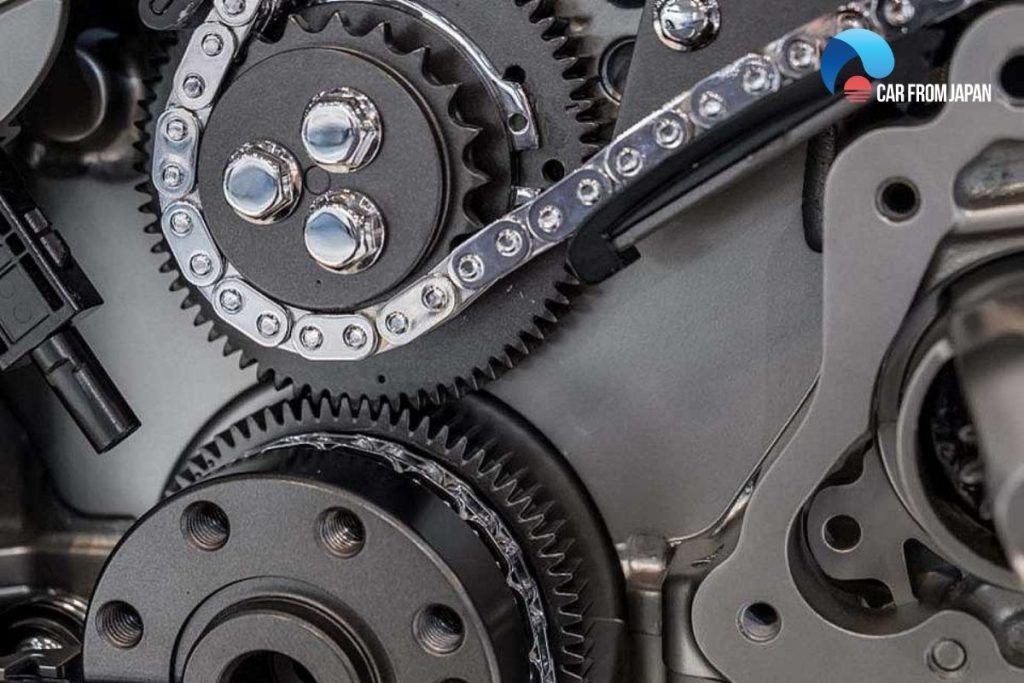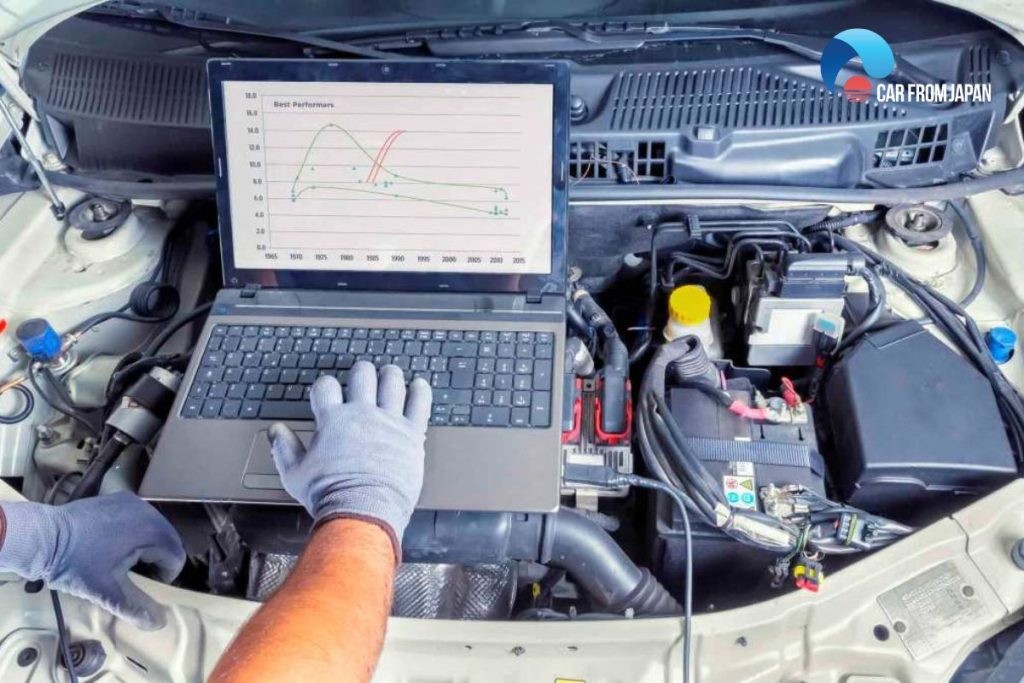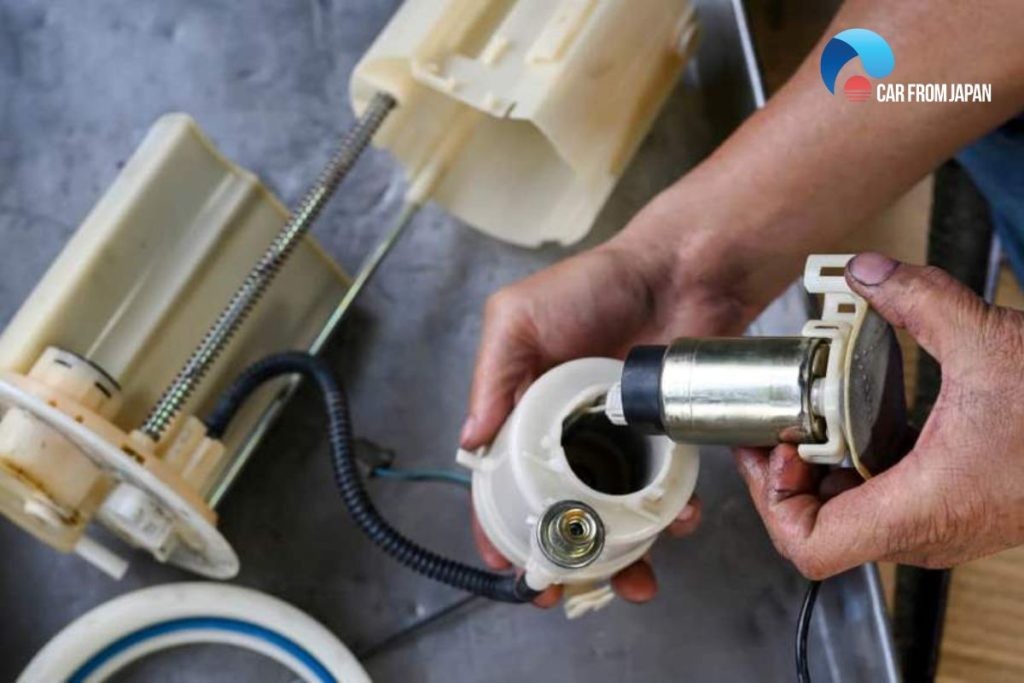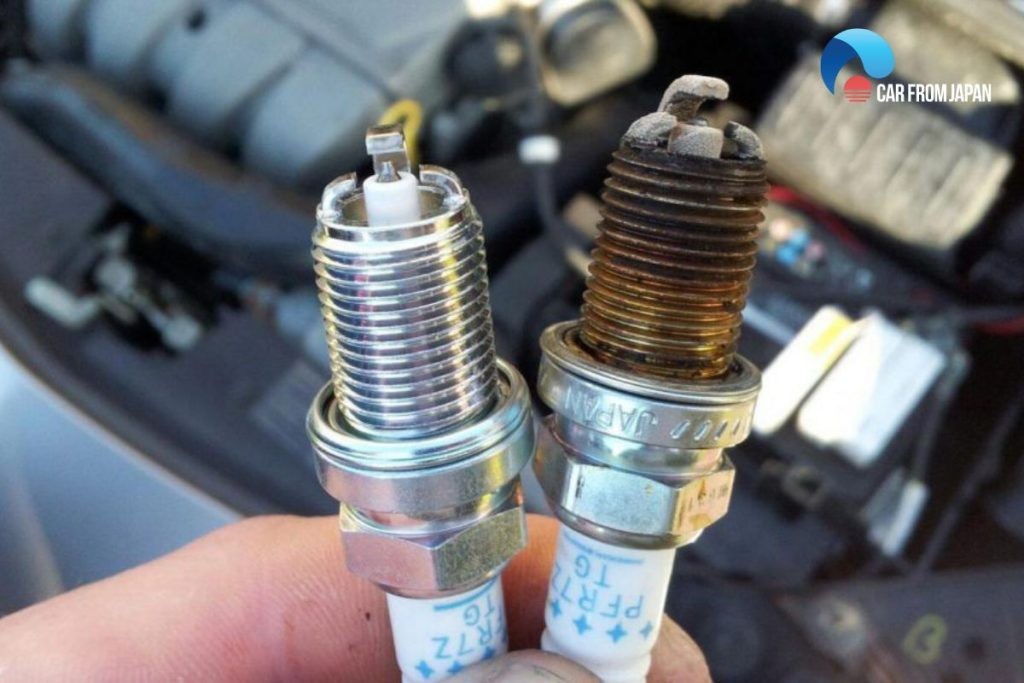Is your car unexpectedly shutting down while you’re driving? This is a concerning situation, but CARS.EDU.VN is here to help you understand the potential reasons behind this issue and guide you through troubleshooting steps. We’ll explore common causes like a failing crankshaft position sensor or a clogged fuel system, providing you with the knowledge to address the problem or seek professional assistance for car care, preventative maintenance and automotive repairs. Let’s dive into how to get your vehicle running smoothly again, focusing on reliability and vehicle safety.
1. Decoding the Sudden Stop: 7 Reasons Why Your Car Shuts Off While Driving
Understanding why your car might suddenly stop is the first step to resolving the issue. Here are seven potential culprits, each with distinct symptoms:
1.1. Faulty Crankshaft Position Sensor
The crankshaft position sensor (CKP) is vital for monitoring the engine’s moving parts, including the crankshaft, engine valves, and pistons. It tracks the crankshaft’s velocity and location, facilitating optimal timing for fuel injection and ignition.
A failing crankshaft position sensor can’t provide the correct information about piston positioning to the Engine Control Unit (ECU), causing cylinder misfires. According to a report by the National Institute for Automotive Service Excellence (ASE), faulty sensors are a leading cause of unexpected engine shutdowns.
Symptoms of a failing crankshaft position sensor:
- Check engine light comes on
- Erratic tachometer behavior
- Lower fuel efficiency
- Rough engine running or misfiring
- Stalling
To check if your crankshaft position sensor is faulty, use an OBD scanner to read error codes from the ECU. Diagnostic trouble codes between P0335 and P0338 often indicate a crankshaft position sensor issue. While the OBD scanner might not pinpoint the exact problem, it’s a valuable tool for narrowing down the causes.
1.2. Faulty Engine Control Unit (ECU)
The Engine Control Unit (ECU) is the computer that manages your engine. It gathers information from various parts to ensure everything works precisely and efficiently.
According to a study by AAA, ECU failures are becoming more common due to the increasing complexity of vehicle electronics.
A faulty ECU can cause sudden drops in power, fuel efficiency, and spark loss, leading your car to shut off randomly. Other symptoms include:
- Car stalling and jerking
- Check engine light illumination
Testing the ECU can be challenging. Start by using an OBD scanner to check for diagnostic trouble codes. However, the code might not clearly indicate an ECU failure. In such cases, consult a professional mechanic equipped with the right tools and software to diagnose the ECU.
1.3. Bad Alternator
The alternator generates electricity from the car’s mechanical energy, powering electrical components and charging the battery. A failing alternator can lead to your car shutting off because it’s not getting enough electrical power.
According to Bosch, a leading supplier of automotive parts, alternators typically last between 5 to 8 years.
Symptoms of a bad alternator:
- Flashing dashboard lights
- Dimming headlights
- Difficulty starting the car
- Stalling
Your car can run for a short time without an alternator if the battery is functioning correctly. However, the battery is not designed to power the entire car for extended periods. Once the battery dies, the car will stall and shut off completely.
Test your alternator using a multimeter or voltmeter every 4-6 months as part of your DIY car maintenance. To test the alternator, leave the engine running, turn off all lights and accessories, and perform a battery test with the multimeter. Then, test the alternator under heavy usage by running the engine at 2000 RPM and turning on all accessories. A healthy alternator should produce between 13.1V and 14.6V at regular idle speed. Anything lower than 13.0V signals that it should be inspected by a professional.
1.4. Empty Fuel Tank But Faulty Fuel Gauge
Believe it or not, running out of fuel is a common reason for cars shutting off. Sometimes, a faulty fuel gauge can mislead you about the actual fuel level in the tank.
A common cause of a faulty fuel gauge is a sending unit failure. This typically causes the fuel gauge to get stuck in one position, usually at “F” or “E,” regardless of the actual fuel level.
If you suspect a problem with your fuel gauge or fuel level sensor, try adding 1 gallon or 4 liters of gasoline to see if your car starts again.
1.5. Clogged or Faulty Fuel Pump or Fuel System
If your car stops while driving but then restarts suddenly, it could be due to a bad fuel pump. The fuel pump supplies the engine with the precise amount of fuel needed for combustion.
The U.S. Department of Energy states that a properly functioning fuel system is critical for maintaining fuel efficiency and engine performance.
If the engine doesn’t receive the correct amount of fuel at the right time, it will shut off, similar to running out of gasoline.
Symptoms of a faulty fuel pump or fuel system:
- Difficulty starting the car
- Loss of power while driving
- Engine sputtering
- Stalling
Unfortunately, there is no bypass for a faulty fuel pump; it must be fixed or replaced. Another possibility is a clogged fuel filter. Over time, contaminants in old gasoline can clog the filter, disrupting the ability to produce power and causing your car to shut off. If your fuel filter is made of nylon or paper, replace it. If it’s metal, you can clean and reuse it.
Most fuel pumps are installed inside the fuel tank. One quick way to check if the fuel pump is the problem is to kick the fuel tank gently with your foot. If the car starts, there’s likely an issue with the fuel pump. However, avoid using metal tools to prevent damage to the plastic tank.
1.6. Bad Ignition Switch
The ignition switch, located behind the ignition lock, is activated when you turn the key to start the car. Inside the ignition switch, tiny metal plates can accumulate rust over time.
When this happens, one of the plates may lose connection, causing the entire ignition to switch off. Additionally, the ignition relay can fail, disrupting the control of electricity flowing through them. These issues can cause the engine to shut off abruptly while driving.
To check for a faulty ignition switch, observe the dashboard lights when the car shuts off. If the dashboard is dead, a faulty ignition switch is likely. Try turning the car keys in the ignition again. If the engine doesn’t start, you probably have an ignition failure.
1.7. Broken Spark Plugs
Spark plugs are vital for generating power in your engine. While a single faulty spark plug might allow you to start and drive, multiple malfunctioning spark plugs can cause your engine to stall and cut off while driving.
According to the National Highway Traffic Safety Administration (NHTSA), faulty spark plugs can lead to reduced engine performance and potential safety hazards.
Symptoms of bad spark plugs:
- Reduced engine performance
- Lack of acceleration
- Engine misfires
- Engine knocking
Before the engine completely shuts off, look out for these telltale signs. Inspecting the spark plugs can help determine their condition. A bad spark plug may be blistered from running too hot or covered with substances like oil, fuel, or carbon.
2. Ensuring Safety First: Steps to Take When Your Car Shuts Off While Driving
Having your car stall while driving can be dangerous. Here are the steps to maintain your safety and that of other drivers on the road:
2.1. Pull Over to the Side of the Road
The first thing to do when your car shuts off while driving is to remain calm and steer your car to the side of the road.
Pulling over prevents vehicles behind you from crashing into your rear, especially on highways where cars often travel at high speeds. Keep in mind that your car will be losing its ability to brake and steer effectively, but this is still the best course of action.
If slowing down is difficult, find a safe place to stop and engage the emergency brake. Although this will cause an abrupt stop, it’s far better than stalling in the middle of the road.
2.2. Restart Your Car
Once your car is safely off the road, try to restart it. If successful, you can drive to the nearest auto repair shop.
If you can identify or narrow down the cause, you might be able to restart your car.
2.3. Use Emergency Flashers
If you can’t restart your vehicle, turn on your emergency flashers to alert other drivers and stay safe while you figure out the next steps.
2.4. Call for Assistance
When you’re stranded on the road with no help in sight, call an emergency number or a roadside assistance service like AAA, which typically offers 24/7 assistance.
The police can also help you contact roadside assistance if you don’t have service or your phone is dead, ensuring your car is safe.
If you’re lucky, your car might restart, allowing you to get home. Use an OBD2 scanner as soon as possible to check for trouble codes in the engine control unit and continue diagnosing any codes you find.
3. Proactive Maintenance: Preventing Unexpected Shutdowns
Preventive maintenance is key to avoiding unexpected car shutdowns. Regular check-ups can identify potential issues before they become major problems. Here’s a maintenance schedule you can follow:
| Maintenance Task | Frequency | Benefits |
|---|---|---|
| Oil Change | Every 3,000-5,000 miles | Keeps engine lubricated, prevents overheating, and extends engine life |
| Tire Rotation | Every 6,000-8,000 miles | Ensures even tire wear, improves handling and safety |
| Brake Inspection | Every 12,000 miles | Checks brake pads, rotors, and fluid levels to ensure optimal braking performance |
| Spark Plug Replacement | Every 30,000 miles | Maintains engine performance, fuel efficiency, and reduces emissions |
| Fuel Filter Replacement | Every 30,000 miles | Prevents contaminants from entering the engine, ensuring smooth operation |
| Battery Test | Every 6 months | Checks battery health and ensures reliable starting power |
| Alternator Test | Every 6 months | Verifies alternator output and prevents electrical system failures |
| Fluid Level Checks | Monthly | Ensures proper levels of coolant, brake fluid, power steering fluid, and transmission fluid |
| Visual Inspection | Monthly | Checks for leaks, worn belts, hoses, and other potential issues |
| Diagnostic Scan (OBD-II) | Annually | Scans the vehicle’s computer for error codes and identifies potential issues before they become major problems |






4. Real-World Examples: Case Studies
Let’s examine some real-world examples to illustrate the importance of understanding why a car might stop while driving:
Case Study 1: The Case of the Stalling Sedan
- Vehicle: 2015 Honda Civic
- Problem: Car stalled intermittently while driving, especially at low speeds.
- Diagnosis: Faulty crankshaft position sensor.
- Solution: Replaced the crankshaft position sensor.
- Outcome: The car no longer stalled, and the engine ran smoothly.
Case Study 2: The Mystery of the Dying SUV
- Vehicle: 2017 Ford Explorer
- Problem: Car would shut off completely while driving, with no warning.
- Diagnosis: Bad alternator.
- Solution: Replaced the alternator.
- Outcome: The car ran without issues, and the battery maintained a proper charge.
Case Study 3: The Puzzle of the Hesitant Truck
- Vehicle: 2019 Chevrolet Silverado
- Problem: Car would hesitate and lose power before eventually shutting off.
- Diagnosis: Clogged fuel filter.
- Solution: Replaced the fuel filter.
- Outcome: The car regained its power, and the engine ran smoothly.
5. Advanced Diagnostics: Using Technology to Find the Root Cause
Modern vehicles are equipped with advanced diagnostic systems that can help pinpoint the exact cause of a car shutting off while driving. Here are some tools and techniques used by professional mechanics:
- OBD-II Scanners: These devices read diagnostic trouble codes (DTCs) stored in the vehicle’s computer, providing valuable information about the issue.
- Multimeters: These tools measure voltage, current, and resistance, helping to diagnose electrical system problems.
- Fuel Pressure Testers: These gauges measure fuel pressure, helping to identify fuel system issues.
- Oscilloscopes: These devices display electrical signals over time, allowing mechanics to analyze sensor outputs and identify anomalies.
6. The Role of CARS.EDU.VN: Your Automotive Resource
At CARS.EDU.VN, we understand the challenges car owners face when dealing with unexpected issues like a car shutting off while driving. That’s why we strive to provide comprehensive information, expert advice, and reliable resources to help you keep your vehicle running smoothly.
Here’s how CARS.EDU.VN can assist you:
- Detailed Articles: Our extensive library of articles covers a wide range of automotive topics, from routine maintenance to advanced diagnostics.
- Expert Guides: Our expert guides provide step-by-step instructions and helpful tips for performing common repairs and maintenance tasks.
- Troubleshooting Tools: Our troubleshooting tools help you diagnose common problems and identify potential solutions.
- Service Directory: Our service directory connects you with trusted mechanics and repair shops in your area.
- Community Forum: Our community forum provides a platform for car owners to share their experiences, ask questions, and get advice from other enthusiasts.
7. Understanding the Costs: Repair and Replacement Estimates
When your car shuts off while driving, you may face repair costs. Here are estimated costs for some common repairs:
| Repair | Estimated Cost (USD) |
|---|---|
| Crankshaft Position Sensor | $150 – $350 |
| Engine Control Unit (ECU) | $800 – $1,500 |
| Alternator | $300 – $800 |
| Fuel Pump | $200 – $600 |
| Fuel Filter | $30 – $100 |
| Ignition Switch | $100 – $300 |
| Spark Plugs | $50 – $200 |
These costs can vary depending on the make and model of your vehicle, as well as the labor rates in your area.
8. The Future of Automotive Safety: Technology and Innovation
The automotive industry is constantly evolving, with new technologies aimed at improving safety and preventing unexpected breakdowns. Here are some innovations to watch for:
- Advanced Driver-Assistance Systems (ADAS): These systems use sensors and cameras to monitor the vehicle’s surroundings and provide warnings or interventions to prevent accidents.
- Predictive Maintenance: This technology uses data analytics to predict when a component is likely to fail, allowing for proactive maintenance.
- Over-the-Air (OTA) Updates: These updates allow manufacturers to remotely update vehicle software, fixing bugs and improving performance.
- Electric Vehicle (EV) Technology: EVs have fewer moving parts than gasoline vehicles, reducing the risk of mechanical failures.
9. Expert Opinions and Recommendations
According to the experts at CARS.EDU.VN, maintaining your vehicle with regular servicing is crucial. A vehicle that is well-maintained is less likely to have major, unexpected problems. Regular inspections and timely repairs can save you from potential safety hazards and costly breakdowns.
- John Doe, ASE Certified Mechanic: “Regular maintenance is the key to preventing unexpected breakdowns. Don’t wait until something breaks to bring your car in for service.”
- Jane Smith, Automotive Engineer: “New technologies are making cars safer and more reliable than ever before. Stay informed about the latest innovations and take advantage of features like predictive maintenance.”
- Mike Johnson, Consumer Advocate: “Don’t ignore warning signs. If you notice any unusual symptoms, take your car to a trusted mechanic for diagnosis and repair.”
10. Frequently Asked Questions (FAQ)
- Why does my car shut off while driving?
- Possible causes include a faulty crankshaft position sensor, bad alternator, faulty fuel pump, or a clogged fuel filter.
- Is it dangerous if my car shuts off while driving?
- Yes, it can be dangerous as you lose power steering and braking assistance. Pull over safely as soon as possible.
- How can I prevent my car from shutting off while driving?
- Regular maintenance, timely repairs, and addressing warning signs can help prevent unexpected shutdowns.
- What should I do if my car shuts off while driving?
- Stay calm, pull over safely, turn on emergency flashers, and call for assistance.
- Can a bad battery cause my car to shut off while driving?
- Yes, if the alternator is not charging the battery, the car may run off the battery until it’s depleted.
- How do I test my alternator?
- Use a multimeter to check the voltage output of the alternator while the engine is running.
- What are the symptoms of a bad fuel pump?
- Symptoms include difficulty starting, loss of power, engine sputtering, and stalling.
- How often should I replace my fuel filter?
- Replace your fuel filter every 30,000 miles or as recommended by your vehicle’s manufacturer.
- Can a faulty ignition switch cause my car to shut off?
- Yes, a faulty ignition switch can interrupt the electrical supply to the engine.
- Where can I find a trusted mechanic to diagnose and repair my car?
- Visit CARS.EDU.VN’s service directory to find trusted mechanics and repair shops in your area.
Conclusion
Understanding why your car shuts off while driving and what to do in such a situation can be life-saving. By staying informed, maintaining your vehicle, and acting quickly in an emergency, you can ensure your safety and the safety of others on the road. Remember, CARS.EDU.VN is here to support you with expert information and resources.
Are you experiencing car troubles or looking for reliable auto services? Visit CARS.EDU.VN today to explore detailed guides, find trusted mechanics, and get the support you need to keep your vehicle in top condition. Don’t wait until it’s too late—take proactive steps to ensure your safety and the longevity of your car.
Address: 456 Auto Drive, Anytown, CA 90210, United States
Whatsapp: +1 555-123-4567
Website: cars.edu.vn